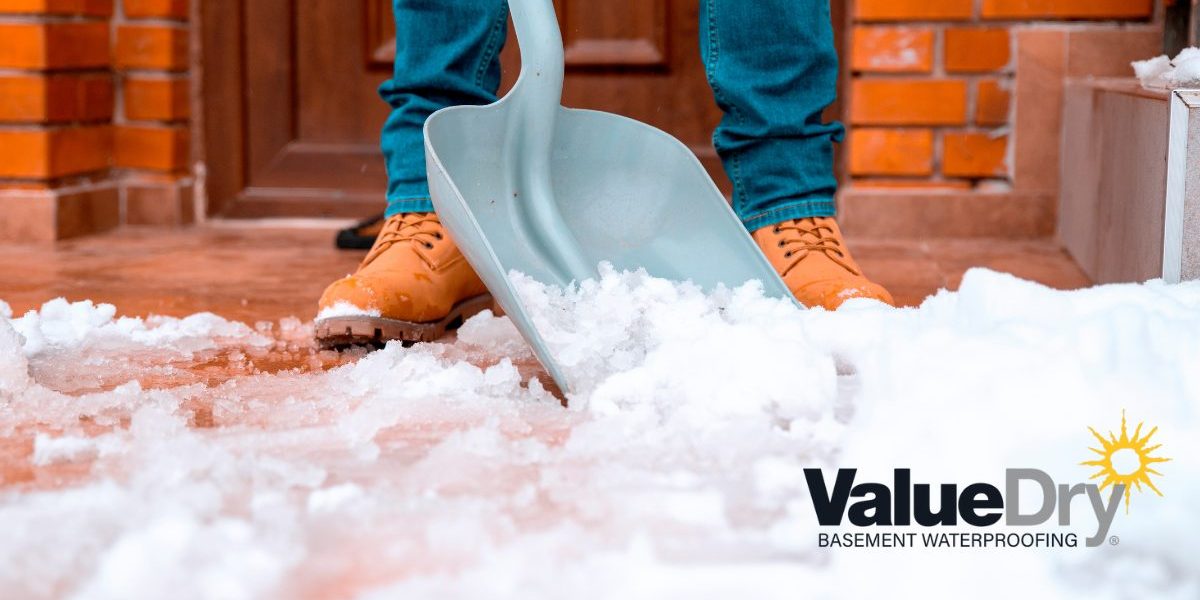How to Prevent Basement Flooding This Winter
- January 20, 2022
- No Comments
Most people associate basement floods with heavy rain in the spring, summer, and fall. But as a basement waterproofing company, we’ve also seen basement flooding and water intrusion occur in winter.
Basement flooding in winter is caused by the heavy snow, snowmelt, and the freeze-thaw cycle we get here in the Mid-Atlantic. When the snow melts on your roof or next to your foundation, it seeps into the ground and builds up next to your foundation. If the ground is frozen, the snow accumulates until the ground thaws, and then it seeps into the ground heading toward your foundation.
Often, the thaw happens when there’s warm rain on top of the snow and frozen soil. If there is an inch of rain frozen in the soil and 12” of snow on top of the ground, and an inch of warm rain falls, it can be like 3” of rain just fell on your seeping foundation.
That freeze-thaw cycle can also create foundation cracks. As the saturated soil presses against your foundation wall, the water searches for a place to escape. For many homeowners, the water seeps through cracks into your basement walls and concrete basement floor. Over time, the water collects, forming puddles and causing winter basement flooding.
Tips to prevent winter basement flooding
Yes, basement flooding is serious, but there are steps you can take to protect your home. Check out the following tips to prevent basement flooding this winter.
- Keep snow away
No, we don’t mean shovel around your entire foundation. But when removing snow from your driveway, patio, and sidewalk, pile it a good distance from your home’s foundation. This helps the snowmelt drain away from your foundation rather than toward it.
- Keep stairwell drains and window well drains free of ice and debris
If you have an exterior basement door at the bottom of an open stairwell, you will need to remove ice and snow build-up, and piles of leaves from the area. Leaves and other debris can block the drain, allowing water to flow into your basement under the door.
Also, consider installing Bilco doors or window well covers over the exterior stairwell or window well. This will prevent rain, sleet, and snow from falling directly into the stairway or window well. The wind may still blow some rain and ice into these areas, but the covers will reduce the amount significantly.
If the drain is very small, you can also consider enlarging it.
- Keep your gutters clean
Check your gutters for leaves and debris clogging the system. If one section of your gutter is overflowing, you may need to get your gutters cleaned as the weather permits. Also, install downspout extenders to direct melted snow as far away from your foundation as possible. Once installed, clear snow away from the downspout extension so the water runoff drains easily.
- Clear snow away from sump pump discharge lines
If your discharge line extends to the street, it can get buried under a mountain of snow when the snowplow goes by. This build-up can freeze the end of the discharge line. However, the discharge line shouldn’t freeze if it’s buried properly since the water inside is warmer than the winter air outside.
After winter and the temperatures start to rise again, the ice and snow will start to melt, and you’ll notice a straight line of melting snow following the path of the discharge pipe. This is a sign the pipe is functioning properly, and water is being directed away from the foundation.
Note: Frozen or blocked discharge lines cause sump pumps to fail even if they are brand new.
- Check your sump pump
If there has been a lot of snow melting, and you haven’t heard your sump pump, check to ensure it’s working. Newer pumps with controllers may have test buttons or lights to tell you it’s on.
For other pumps, you have to test it manually by pouring about 5 gallons of water into the sump pit. That should be enough to raise the float and cause the pump to run. If you determine your pump is not working, call us immediately.
- Get a backup sump pump
Installing a battery-backup sump pump protects you if your primary pump fails or the power goes out during heavy winds or an ice storm. You may also want to check with your homeowner’s insurance company about adding a sump pump rider to your policy. For a nominal fee, this can protect your finishings and personal belongings in the event of flooding due to a failed pump.
Call for help
If you find out that a sump pump is not working or you have puddles or standing water in your basement, call for help immediately. Value Dry Waterproofing will arrive at your premises with a custom solution and also suggest other methods to prevent basement flooding.
Schedule your free basement inspection
If you’ve had water seepage in your basement this winter, or if you’re considering remodeling or finishing your basement, don’t waste any more time before getting your dry basement. Schedule a FREE basement inspection to address any water intrusion before it gets worse. Our inspectors have years of experience and will thoroughly evaluate your basement and make customized waterproofing recommendations for your home.
Basement waterproofing offers a permanent solution that helps you protect the structural integrity of your home and your family’s health. To schedule your inspection, fill out the contact form or call us at (888) 768-2583. We serve homeowners in Maryland, Washington DC, Delaware, Northern Virginia, and the Eastern Panhandle of West Virginia.


